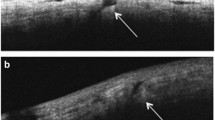Abstract
Background
The aim of the study was to evaluate the safety and functional outcome of a small incision, sutureless vitrectomy in the treatment of idiopathic epiretinal membranes (ERM) compared with a standard 20-gauge vitrectomy system.
Methods
Forty-six consecutive patients with idiopathic ERM were recruited for this study and prospectively evaluated. In group 1 (n=26) we used a transconjunctival sutureless 25-gauge vitrectomy system (TSV), patients in group 2 (n=20) were operated on using a standard 20-gauge vitrectomy system. The ERM was removed and the internal limiting membrane (ILM) was peeled in all eyes. Surgery-related complications, operating time, intraoperative balanced salt solution (BSS) consumption, postoperative discomfort, postoperative intraocular inflammation, lens opacification, and long-term visual outcome are reported and compared.
Results
No surgery-related complications were observed in either group. Operating time was shorter in group 1 compared with group 2 (mean 15.6 and 29.6 min respectively). Intraoperative amount of BSS consumption was less in group 1 (mean 28 ml in group 1 and 42 ml in group 2). Postoperative discomfort and intraocular inflammation were significantly reduced in the 25-gauge group. In the 20-gauge group cataract formation requiring surgery was observed in two eyes. Visual acuity improved significantly in both groups. The 25-gauge group improved on average by more lines of vision and the improvement in vision was more rapid.
Conclusion
The TSV system is a safe and efficient surgical technique for ERM surgery. Operating time is significantly reduced, minimizing surgery-induced trauma, and reducing postoperative intraocular inflammation and the patients’ discomfort. The incidence of cataract formation may be less using TSV. Postoperative recovery is accelerated.

Similar content being viewed by others
References
Barraquer RI, Alvarez de Toledo JP, Montané D, Escoto RM, Garcia Torres C, Bennani-Tazzi M (1998) Fixed-dose combination of 0.1% diclofenac plus 0.3% tobramycin ophthalmic solution for inflammation after cataract surgery: a randomized, comparative, active treatment-controlled trial. Eur J Ophthalmol 8:173–178
Chalam KV, Malkani S, Shah VA (2003) Intravitreal dexamethasone effectively reduces postoperative inflammation after vitreoretinal surgery. Ophthalmic Surg Lasers Imaging 34:188–192
Chen JC (1996) Sutureless pars plana vitrectomy through self-sealing sclerotomies. Arch Ophthalmol 114:1273–1275
Cherfan GM, Michles RG, de Bustros S, Enger C, Glaser BM (1991) Nuclear sclerotic cataract after vitrectomy for idiopathic epiretinal membranes causing macular pucker. Am J Ophthalmol 111:434–438
Cho YJ, Lee JM, Kim SS (2004) Vitreoretinal surgery using transconjunctival sutureless vitrectomy. Yonsei Med J 45:615–620
Chylack LT Jr, Wolfe JK, Singer DM, Leske MC, Bullimore MA, Bailey IL, Friend J, McCarthy D, Wu SY (1993) The Lens Opacities Classification System III. The longitudinal study of the cataract study group. Arch Ophthalmol 111:831–836
De Bustros S, Thompson JT, Michels RG, Enger C, Rice TA, Glaser BM (1988) Nuclear sclerosis after vitrectomy for idiopathic epiretinal membranes. Am J Ophthalmol 105:160–164
De Bustros S, Thompson JT, Michels RG, Rice TA, Glaser BM (1988) Vitrectomy for idiopathic epiretinal membranes causing macular pucker. Br J Ophthalmol 72:692–695
Fujii GY, De Juan E Jr, Humayun MS, Pieramici DJ, Chang TS, Ng E, Barnes A, Wu SL, Drew N, Sommerville BS (2002) A new 25-gauge instrument system for transconjunctival sutureless vitrectomy surgery. Ophthalmology 109:1807–1813
Fujii GY, De Juan E Jr, Humayun MS, Chang TS, Pieramici DJ, Barnes A, Kent D (2002) Initial experience using the transconjunctival sutureless vitrectomy system for vitreoretinal surgery. Ophthalmology 109:1814–1820
Hsuan JD, Brown NA, Bron AJ, Patel CK, Rosen PH (2001) Posterior subcapsular and nuclear cataract after vitrectomy. J Cataract Refract Surg 27:437–444
Margherio RR, Cox MS Jr, Trese MT, Murphy PL, Johnson J, Minor LA (1985) Removal of epimacular membranes. Ophthalmology 92:1075–1083
McDonald HR, Verre WP, Aaberg TM (1986) Surgical management of idiopathic epiretinal membranes. Ophthalmology 93:978–983
Michels RG (1984) Vitrectomy for macular pucker. Ophthalmology 91:1384–1388
Milibak T, Suveges I (1998) Complications of sutureless pars plana vitrectomy through self-sealing sclerotomies. Arch Ophthalmol 116:119
Ogura Y, Takanashi T, Ishigooka H, Ogino N (1991) Quantitative analysis of lens changes after vitrectomy by fluorophotometry. Am J Ophthalmol 111:179–183
Park DW, Dugel PU, Garda J, Sipperley JO, Thach A, Sneed SR, Blaisdell J (2003) Macular pucker removal with and without internal limiting membrane peeling: pilot study. Ophthalmology 110:62–64
Rahman R, Rosen PH, Riddell C, Towler H (2000) Self-sealing sclerotomies for sutureless pars plana vitrectomy. Ophthalmic Surg Lasers 31:462–466
Saito Y, Lewis JM, Park I, Ikuno Y, Hayashi A, Ohji M, Tano Y (1999) Nonvitrectomizing vitreous surgery: a strategy to prevent postoperative nuclear sclerosis. Ophthalmology 106:1541–1545
Sawa M, Saito Y, Hayashi A, Kusaka S, Ohji M, Tano Y (2001) Assessment of nuclear sclerosis after nonvitrectomizing vitreous surgery. Am J Ophthalmol 132:356–362
Thelen T, Verbeek AM, Tilanus MA, van den Biesen PR (2003) A novel technique for self-sealing, wedge-shaped pars plana sclerotomies and its features in ultrasound biomicroscopy and clinical outcome. Am J Ophthalmol 136:1085–1092
Willis AW (1989) Surgical treatment of idiopathic macular epiretinal membrane. Ophtalmologie 3:29–30
Author information
Authors and Affiliations
Corresponding author
Additional information
The authors have no financial interests related to this publication.
Rights and permissions
About this article
Cite this article
Rizzo, S., Genovesi-Ebert, F., Murri, S. et al. 25-gauge, sutureless vitrectomy and standard 20-gauge pars plana vitrectomy in idiopathic epiretinal membrane surgery: a comparative pilot study. Graefe's Arch Clin Exp Ophthalmo 244, 472–479 (2006). https://doi.org/10.1007/s00417-005-0173-6
Received:
Revised:
Accepted:
Published:
Issue Date:
DOI: https://doi.org/10.1007/s00417-005-0173-6




